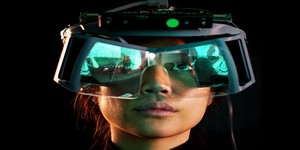Leap Motion brings hand tracking to mobile VR
December 6, 2016 | 10:50
Companies: #leap-motion #oculus-rift #samsung

Gesture-tracking specialist Leap Motion has announced the creation of a new sensor platform designed for use with mobile devices, as a means of bringing the hands of a mobile VR user into the virtual realm.
Originally launched as an addon for desktop and laptop PCs and designed to track a user's hands for gesture recognition, Leap Motion's technology has not been an unalloyed success. Despite a partnership with HP to integrate Leap Motion hardware into selected laptops, third-party support of the system has proved lacking. When the current virtual reality boom took off, the company saw a new direction and leaped in with both feet by offering the ability to integrate a Leap Motion sensor with the Oculus Rift virtual reality headset in order to track the position of a user's hands and fingers. The result: the ability to interact with virtual objects and environments without the need to use physical controllers.
With the current range of virtual reality hardware being priced well beyond impulse-buy levels and requiring a beefy and expensive gaming PC, though, Leap Motion's VR push hasn't been likely to ingratiate the company into the mass market - until now. The company has announced the development of a Leap Motion variant designed for use with smartphone-based virtual reality headsets like Samsung's Gear VR and Google's Cardboard, potentially bringing the technology to a much wider audience.
'The challenges to build a tracking platform in this space have been immense. We needed to build a whole new Leap Motion sensor with higher performance and much lower power,' claimed Leap Motion's David Holz in the announcement. 'We needed to make the most sophisticated hand tracking software in the world run at nearly 10 times the speed all while making it smoother and more accurate than ever before. At the same time, we wanted to address the biggest request from the VR community, which is field of view. While our PC peripheral remains unrivalled at 140×120 degrees, we’ve found in virtual reality there is reason to go even further. So we’ve built our next-generation system with the absolute maximum field of view that a single sensor can support on a VR headset, which is 180×180 degrees.'
The company's initial implementation of what it has dubbed the Leap Motion Mobile Platform integrates the new hardware into a Samsung Gear VR headset, which the company has begun shipping to potential hardware partners in the hopes of securing a licensing or manufacturing agreement. 'This is the beginning of an important shift towards mobile and ubiquitous wearable displays that will eventually be as easy and casual to use as a pair of glasses,' claimed Holz. 'The ultimate result of which will be the merging of our digital and physical realities.'
Leap Motion has not indicated when, or even if, a commercial version of the mobile platform will be released, nor at what price.
Originally launched as an addon for desktop and laptop PCs and designed to track a user's hands for gesture recognition, Leap Motion's technology has not been an unalloyed success. Despite a partnership with HP to integrate Leap Motion hardware into selected laptops, third-party support of the system has proved lacking. When the current virtual reality boom took off, the company saw a new direction and leaped in with both feet by offering the ability to integrate a Leap Motion sensor with the Oculus Rift virtual reality headset in order to track the position of a user's hands and fingers. The result: the ability to interact with virtual objects and environments without the need to use physical controllers.
With the current range of virtual reality hardware being priced well beyond impulse-buy levels and requiring a beefy and expensive gaming PC, though, Leap Motion's VR push hasn't been likely to ingratiate the company into the mass market - until now. The company has announced the development of a Leap Motion variant designed for use with smartphone-based virtual reality headsets like Samsung's Gear VR and Google's Cardboard, potentially bringing the technology to a much wider audience.
'The challenges to build a tracking platform in this space have been immense. We needed to build a whole new Leap Motion sensor with higher performance and much lower power,' claimed Leap Motion's David Holz in the announcement. 'We needed to make the most sophisticated hand tracking software in the world run at nearly 10 times the speed all while making it smoother and more accurate than ever before. At the same time, we wanted to address the biggest request from the VR community, which is field of view. While our PC peripheral remains unrivalled at 140×120 degrees, we’ve found in virtual reality there is reason to go even further. So we’ve built our next-generation system with the absolute maximum field of view that a single sensor can support on a VR headset, which is 180×180 degrees.'
The company's initial implementation of what it has dubbed the Leap Motion Mobile Platform integrates the new hardware into a Samsung Gear VR headset, which the company has begun shipping to potential hardware partners in the hopes of securing a licensing or manufacturing agreement. 'This is the beginning of an important shift towards mobile and ubiquitous wearable displays that will eventually be as easy and casual to use as a pair of glasses,' claimed Holz. 'The ultimate result of which will be the merging of our digital and physical realities.'
Leap Motion has not indicated when, or even if, a commercial version of the mobile platform will be released, nor at what price.

MSI MPG Velox 100R Chassis Review
October 14 2021 | 15:04








Want to comment? Please log in.